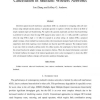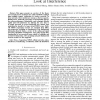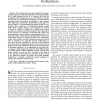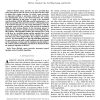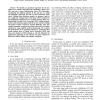124
Voted
JSAC
2010
14 years 7 months ago
2010
Downlink spatial intercell interference cancellation (ICIC) is considered for mitigating other-cell interference using multiple transmit antennas. A principle question we explore ...
120
Voted
JSAC
2010
14 years 7 months ago
2010
This paper presents an overview of the theory and currently known techniques for multi-cell MIMO (multiple input multiple output) cooperation in wireless networks. In dense network...
132
Voted
JSAC
2010
14 years 7 months ago
2010
Abstract--Wireless sensor networks (WSNs) deployed in hostile environments are vulnerable to clone attacks. In such attack, an adversary compromises a few nodes, replicates them, a...
123
click to vote
JSAC
2010
14 years 7 months ago
2010
Abstract--The continuously increasing complexity of communication networks and the increasing diversity and unpredictability of traffic demand has led to a consensus view that the ...
94
Voted
JSAC
2010
14 years 7 months ago
2010
132
Voted
JSAC
2010
14 years 7 months ago
2010
Robotic sensor networks are more powerful than sensor networks because the sensors can be moved by the robots to adjust their sensing coverage. In robotic sensor networks, an impor...
97
Voted
JSAC
2010
14 years 7 months ago
2010
Underwater Acoustic Sensor Networks (UW-ASNs) consist of stationary or mobile nodes such as Autonomous Underwater Vehicles (AUVs), which may be classified as propellerdriven vehicl...
122
click to vote
JSAC
2010
14 years 7 months ago
2010
Abstract-- We identify an analytical expression for the distortion of a scalable video bitstream containing a Base Layer (BL) and one or more Enhancement Layer (EL) bitstreams. Con...
141
Voted
JSAC
2010
14 years 7 months ago
2010
Abstract--Sensor networks can benefit greatly from locationawareness, since it allows information gathered by the sensors to be tied to their physical locations. Ultra-wide bandwid...
115
Voted
JSAC
2010
14 years 7 months ago
2010
The prior art construction of sets of balanced codewords by Knuth is attractive for its simplicity and absence of look-up tables, but the redundancy of the balanced codes generated...
